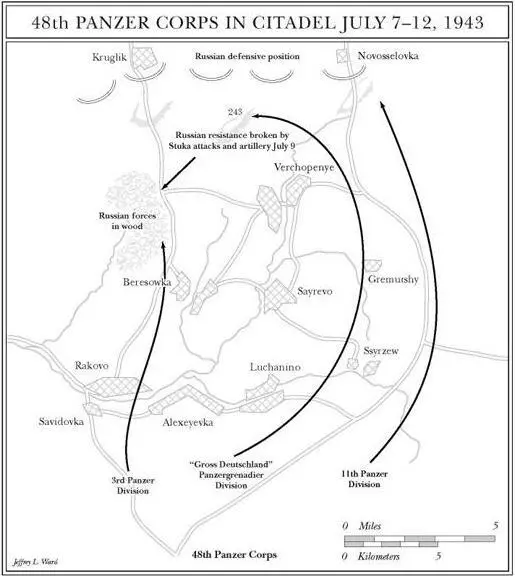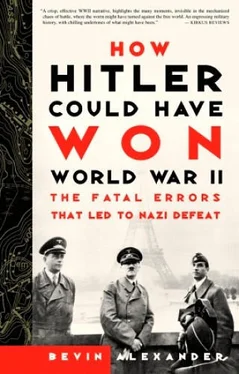Hitler’s plan was for Hermann Hoth’s 4th Panzer Army on the south and Walter Model’s 9th Army on the north to advance toward each other. The main thrust of 4th Panzer Army was to be delivered by 48th Panzer Corps and SS Panzer Corps. East of Kursk they were to meet 9th Army advancing south with 800 tanks.
In the south, 48th Panzer Corps, with 300 tanks and 60 assault guns in the “Gross Deutschland” Panzergrenadier and the 3rd and 11th Panzer Divisions, was to attack on the west, while, about ten miles to the east, SS Panzer Corps’s three Waffen-SS divisions of about the same strength were to thrust along the railway line running north from Belgorod. M. E. Katukov’s 1st Tank Army was waiting to block both corps.
The battlefield was mostly an open plain, covered with grainfields, broken by numerous valleys, small copses of trees, villages here and there, and a few rivers and streams. The ground rose slightly to the north, giving the Russians better observation.
The Germans had assembled their forces in secrecy, but the Russians knew their positions and approximate strength.
The battle opened on July 5 with a sharp artillery preparation and an air bombardment, using Stukas, new Focke-Wulf 190-A fighter-bombers, and new Henschel 129 B2 tank-killer aircraft. The Germans had mounted 30-millimeter automatic cannons on Stukas and Henschels, which could penetrate the thin armor on the tops of the T-34s.
But neither 48th Corps nor SS Panzer Corps was able to penetrate the Russian line. Not only was the entire area infested with mines, but Soviet guns shelled the panzers heavily, aircraft flew in and destroyed a number of tanks, and Russian armor occupied high ground and targeted German panzers.
The Russians had mastered new antitank tactics developed by the Germans. They distributed numerous “antitank fronts” all over a defended area. Each front had ten antitank guns under a single commander. The aim was to draw a German tank into a web of these guns, firing at it from several locations. The Russians fortified their antitank fronts with minefields and antitank ditches. Even after penetrating miles into Russian lines, the Germans found themselves in the midst of minefields and facing more antitank fronts.
To guard against these defenses, German armor advanced in a wedge (Panzerkeil), with the heaviest tanks in the spearhead. Tigers could break an antitank front, but Mark IVs could not, and Panzerkeile were generally able to advance only by delivering concentric tank fire on the AT guns. Even so, losses were often heavy.
On the north, Hoth’s 9th Army had heavy going from the outset. Russian defenses were formidable, and the main hope of the Germans, ninety Tiger tanks made by Ferdinand Porsche (who had designed the Volkswagen automobile), had no machine guns. As Guderian wrote, they “had to go quail-shooting with cannons.” The Tigers could not neutralize enemy rifles and machine guns, so German infantry was unable to follow them. Russian infantry, in no danger of being shot down, approached some of the Tigers and showered the portholes with flamethrowers, or disabled the machines with satchel charges. The Tigers were shattered, the crews suffered high losses, and Model’s attack bogged down after penetrating only six miles.
The experience of 48th Corps demonstrated the kind of war now being fought in Russia. The corps could make little progress till July 7, when it finally broke through on both sides of a village (Ssyrzew), and advanced four miles. A “Gross Deutschland” battle group then moved north six miles and attacked a hill (243) that had been holding up 3rd Panzer Division on the left flank, but the battle group broke down in front of the hill.
On July 9, 3rd Panzer finally was able to swing to the west of the Russians blocking it, but was stopped by more enemy in a small forest four miles southwest of Hill 243 and three miles northwest of Beresowka village. “Gross Deutschland” Division evicted the Russians from Hill 243 with the help of a Stuka attack and, in a series of bitter engagements, drove the surviving Russian tanks into the wood.

It looked as if the enemy on the left flank had been eliminated, and Otto von Knobelsdorff, the corps commander, ordered “Gross Deutschland” to turn north, hoping to break through, since Model’s attack had collapsed. But the Russians counterattacked out of the wood and overran 3rd Panzer, forcing “Gross Deutschland” to turn back and rescue the division in new headlong attacks that finally drove the Russians out of the wood, but left the corps too weak to advance.
Meanwhile 11th Panzer on the corps’s east flank was unable to do more than defend against repeated Russian tank attacks. SS Corps east of 11th Panzer at first also could do little but ward off tank attacks, but slowly each SS division chopped holes in the enemy front, advancing step by step.
On July 12, SS Panzer Corps’s slugging match reached Prokhorovka Station on the railway line, twenty-one miles past the jump-off point. This penetration was dangerous, and Marshal Zhukov authorized a counterattack by 5th Guards Tank Army under P. A. Rotmistrov.
The resulting collision developed into the greatest tank battle in history. SS Panzer Corps had about 400 tanks, the Russians twice as many. The surviving Tiger and Panther tanks with their 88-millimeter cannons and thick armor could engage the Russian tanks beyond the range of the T-34s.
To close the distance to a point that the T-34s could be effective, the Russians launched an almost suicidal charge across the open, rolling plain. In the terrible dust-shrouded melee that followed, the Germans lost their long-range advantage, and Russian and German armored vehicles fought it out in almost point-blank gun battles. Rotmistrov lost more than 400 of his tanks, but the Germans lost 320.
At the end of July 12 Prokhorovka was a graveyard of burned-out tanks, but the Russians had stopped the German offensive. Tank losses had been staggering. Not only had Porsche’s Tigers failed, but the Panthers were breaking down because of their drive problems and were easily set ablaze because the oil and gasoline feeding systems were inadequately shielded. Of eighty Panthers at the start, only a few remained.
Hitler summoned Manstein and Kluge to his headquarters in East Prussia on July 13 and informed them that the attack must be called off at once. The Allies had landed on Sicily, and troops had to be transferred to the Mediterranean.
The Russian high command had done a superb job, yielding ground, taking the strength out of the German attack with minefields and antitank defenses. Though Russian tank losses were much greater than German, the Russians still had a great superiority in armor, and pushed 4th Panzer Army back to its start line by July 23.
The strategic initiative now passed to the Russians. They did not relinquish it for the remainder of the war.
On July 12, Markian M. Popov’s Briansk Front launched an offensive against the Orel salient to the north of Kursk, and by August 5 he had pushed the Germans entirely out of the salient.
On August 4, Nikolai F. Vatutin’s Voronezh Front in the southern end of the Kursk salient attacked 4th Panzer Army’s weakened line, and captured Belgorod the next day. Exploiting the German exhaustion, Vatutin drove eighty miles in the next week, pushing toward the rear of Kharkov and its communications with Kiev.
In the second half of August eighteen Soviet armies pressed westward on a front of 270 miles. The main thrust was against Army Group South, which faced forces three times the size of its own.
Against Army Group Center, Popov advanced from Orel on Bryansk, ousting the Germans in mid-September, while other Russian columns squeezed them out of Smolensk on September 25. German forces slowly fell back to a chain of bastion towns along the upper Dnieper—Zhlobin, Rogachev, Mogilev, and Orsha—and Vitebsk on the Dvina.
Читать дальше



![Джонатан Димблби - Barbarossa - How Hitler Lost the War [calibre]](/books/385421/dzhonatan-dimblbi-barbarossa-how-hitler-lost-the-w-thumb.webp)









